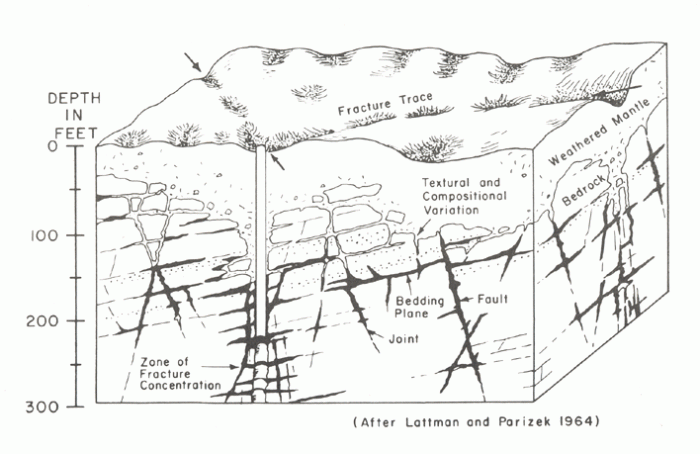Remember that this unit on water and lesson on groundwater present only a broad overview of some very complex topics. Here you will have an opportunity to revisit and expand your knowledge of some of the topics covered in part 2 of this lesson—I consider the concepts presented here to be important for understanding links between surface and groundwater. To me, these concepts highlight the complex interplay of surface and subsurface processes that are active in and affect the Critical Zone.

Reading assignment
Review the following information and resources:
- Confined v. unconfined aquifers
- Primary porosity and diffuse flow v. fracture or conduit porosity and flow: Many rocks and sediments contain space called pores between the individual solid grains that comprise the rock or sediment. This is called primary porosity. If the pores are interconnected then the material is considered to be permeable and fluids can flow through the interconnected pores. This type of fluid flow is known as diffuse flow. Sediments and rock can undergo substantial changes when they are buried and subjected to increased pressure and temperature, or when they are weathered at Earth's surface. Some of these processes can lead to changes in the primary porosity and/or the development of porosity separate from primary porosity—this is called secondary porosity. Sometimes secondary porosity can include the development of large fractures in the rock or conduits, like caves in limestone or lava tubes in basalt. Typically larger fluid volumes can pass through fractures and conduits, thus a different name, fracture or conduit flow, is used to describe this flow regime. Imagine if you can water moving between grains of sand at the beach versus through Mammoth Cave in Kentucky and you will have grasped the difference between diffuse and fracture/conduit flow.
- Gaining and losing streams: The term gaining stream refers to a stream in which the water table in the surrounding flood plain is higher than the water level in the stream. Thus, water flows from the flood plain sediments into the stream channel and stream flow increases in volume downstream. A losing stream is the opposite: water from the stream channel percolates into the subsurface because the water table in the surrounding sediments is below the water level in the stream channel—stream flow decreases downstream.
- Groundwater flow and effects of pumping
Check this out . . .
You can learn more about groundwater at USGS. More importantly, you can access a number of resources, including posters for your classroom, at this site. I highly recommend spending time here.
A detailed map of Earth's groundwater resources can be viewed and downloaded at WHYMAP.